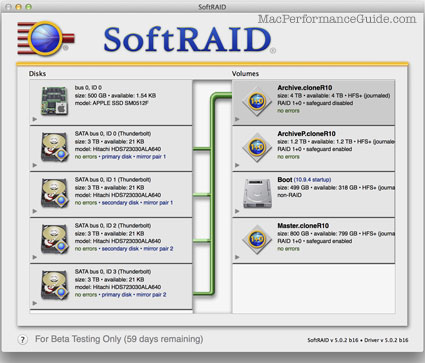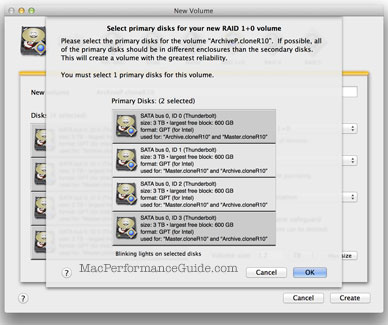
$220 SAVE $130 = 37.0% Western Digital 16.0TB Western Digital Ultrastar DC HC550 3.5-in… in Storage: Hard Drives
|

|

|

|

|

|

|

|

|

|
Software RAID 1+0 (Striped Mirrors) in SoftRAID
Related: backup, fault tolerance, Other World Computing, RAID, RAID-1, RAID-10, SoftRAID, storage, Thunderbolt, video, weather events
SoftRAID offers RAID 1+0 (striped pair of mirrors).
RAID 1+0 is an excellent fault tolerant configuration that also offers high performance. Usable capacity is 1/2, just as with a RAID-1 mirror (e.g., 4 X 4TB drives yields 8TB of usable capacity).
The added fault tolernace is a big plus: with dual enclosures suitably configured as RAID 1+ 0, the RAID can survive not just a drive loss, but loss of an entire enclosure (e.g., failure of its power supply). And it’s fast also.
A good way to do this is with dual OWC Thunderbay units using 4 drives 9two in each Thunderby) or 8 drives (four in each Thunderbay).
Compared to Apple’s Disk Utility, SoftRAID has a better interface, notifications and warnings, and does a better job of recovering from failures. It also has a “fast mirror rebuild feature”, which can be used for highly-efficient backups (“break” a mirror, then sync it up again later).
See failure recovery further below to understand what happens.
Example: three RAID 1+0 volumes on four drives
MPG had four 3TB drives to put to use in an OWC Thunderbay IV. But a 3TB drive/volume was too small for a clone of Archive (3.2TB and growing) which meant that it would have required two drives to make a volume. Yet 12TB (4 X 3TB) was about twice the total storage capacity needed for all the desired Stuff.
With excess capacity, one might as well enjoy fault tolerance and performance at the same time.
This is a single enclosure example, but the four drives could be located across two enclosures, even after first making the RAID in one enclosure—powerful flexibility that cannot be achieved with a hardware RAID 1+0.
Here a RAID 1+0 yields 6TB usable capacity (total across 3 volumes) with excellent fault tolerance. In this particular case, three volumes intended for clone backups were created, corresponding to three master/original volumes (Archive, ArchiveP, Master). A RAID-5 could have been used for 9TB total capacity, but the extra capacity was not needed in the foreseeable future, so the higher fault tolerance of RAID 1+0 made sense.

Selecting the primaries for the RAID 1+0
With a RAID 1+0, selection of the primary drives is a key idea: for maximum fault tolerance, choose primaries in separate enclosures (if using two or more enclosures). That way, the RAID is protected against both drive failure and failure of the enclosure itself (or its power supply).
SoftRAID makes this easy by blinking the disk lights on the enclosures for the drives that are selected in this dialog; select drives in different enclosures as primaries. If there is only one enclosure, then any two drives will do.

Seagate 22TB IronWolf Pro 7200 rpm SATA III 3.5" Internal NAS HDD (CMR)
SAVE $60

 diglloydTools™
diglloydTools™

